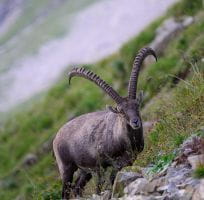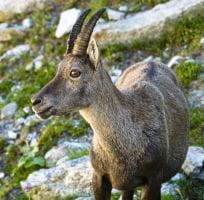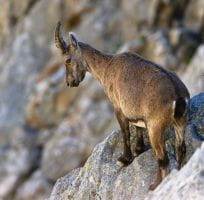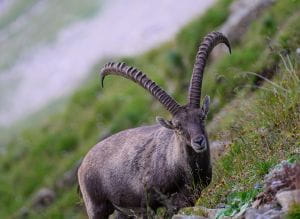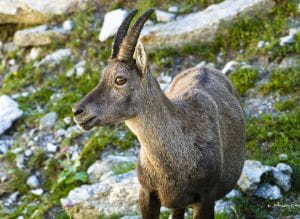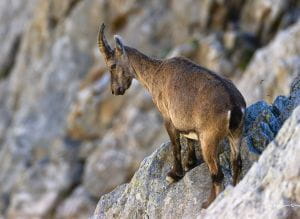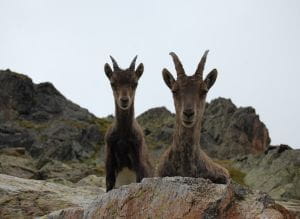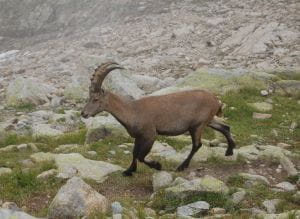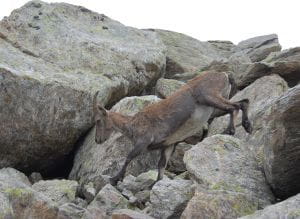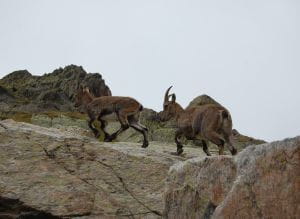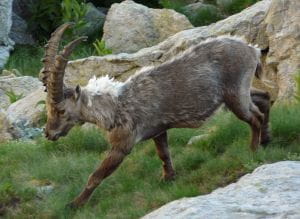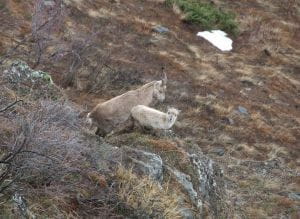First endangered species saved
by conservation measures
Present in the Alpine arc for several thousand years, the ibex came very close to extinction in the 19th century. At the time, the population was estimated at around a hundred individuals, spread across the Vanoise massif in France and the Grand Paradis massif in Italy.
For Dominique Gauthier, an expert on the species, the ibex benefited from the first conservation measures for an animal species (1821), prompted the creation of the first large-scale protected areas (Grand Paradis Royal Hunting Reserve – 1822) which became a National Park in 1922 and motivated the birth of the first French National Park: La Vanoise in 1963.
These protected areas and numerous reintroduction campaigns have enabled the ibex to recolonize its original range and even extend it. The ibex is present inItaly, in France, in Switzerland, in Germany, in Austria and in Slovenia. The worldwide population is estimated (in 2020) at more than 50,000 individuals.
Today, the Alpine Ibex enjoys a high degree of protection. It is listed in appendix III of the Convention on the Conservation of European Wildlife and Natural Habitats (Bern Convention) and in appendix V of the European Habitats Fauna Flora Directive.
In France, the species is listed in appendix V of the European Habitats Fauna Flora Directive.
In France, the species is protected and included in article 2 of the list of terrestrial mammals protected throughout the country.
A general goat-like appearance… with elegance to boot
The Alpine ibex is a stocky, rather short-legged animal. With hooves that are particularly grippy on rock, the ibex moves with disconcerting agility over the steepest cliffs. Its horns, which can reach 1 metre in adult males, make it easy to distinguish from chamois or mouflon.
Sexual dimorphism is marked in ibexes.
Sexual dimorphism is marked in the ibex. The female weighs an average of 60 kg with a height at the withers of 75 cm; the larger male reaches 90 cm at the withers, with an average weight of over 100 kg. Note here that the male wears a small beard under the chin.
The coat varies from brown to gray-brown in summer. The belly and buttocks are white, with the legs turning black. The coat becomes thicker, longer and darker in autumn. This coat is very thick in winter, protecting it from the cold. From April onwards, it becomes cumbersome and the animal gets rid of it by rubbing against trees and rocks.
A high-perched life
The ibex is a rupicolous species, meaning that high cliffs and steep rock faces remain its preferred environment. Especially if they face south, because snow melts faster there. It avoids forested areas, which it doesn’t seem to particularly like.
In the Alps, although in winter it descends into the valleys to find food, in summer it prefers to return to the high escarpments. Up to an altitude of 3,300 m, where it finds the pastures abandoned by other herbivores, both wild and domestic.
In the Alps, although it descends into the valleys in winter to find its food, in summer it prefers to return to the high escarpments.
A diurnal animal with gregarious behavior…
The ibex is essentially a diurnal animal, which is no longer very common, as wildlife is increasingly disturbed by human activities during the day.
Herbivorous, it seeks its food from the early hours of the day and at the end of the day before nightfall.
The rest of the time, it ruminates or rests, lying on promontories well exposed to the sun where it is easy to observe. All the more so as its natural predators are wary of its strength and ability to get out of harm’s way in a matter of moments on the surrounding rocks.
And all the more so as this species is a very rare and rare breed.
And all the more so as this gregarious animal lives in herds: adult males on one side, females and young on the other. It can happen on territories where densities are low that the herds merge, but always respecting the separation of the sexes!
…and with varying diets
An opportunistic herbivore, the ibex will move to high-altitude mountain pastures (up to 3,300 m) in summer to consume wild grasses and legumes. Up to 20 kg per day!
As autumn arrives, it heads back down to areas where vegetation, however poor, remains accessible. In winter, it is able to dig through the snow to access resources still present: dried grass, lichens, mosses. Less digestible shrubs such as juniper, rhododendron or boxwood complete its diet. These are not enough to cover its natural needs, and the ibex loses a lot of weight: up to 50% in males!
When spring arrives, the animal heads down into the valleys to access the first shoots of grass, sometimes to the detriment of farmers. It also feeds on the young shoots of hazel trees, alders and, more generally, any buds that are accessible.
The ibex boasts a wide range of species.
The ibex drinks little and is usually content with snow in winter and spring, and morning dew in summer. On the other hand, it does need salt, which it finds near domestic herds (salt stones) but also in natural salt pans, found just about everywhere in the mountains.
The ibex needs salt to survive.
The mating season in the middle of winter
Although they live apart all year round, the adult male and female herds meet up again at the end of November for the rut, which lasts until mid-January.
The polygamous males engage in noisy rather than violent jousting, throwing head against head. The young males don’t take part, merely watching and learning! They’ll have to wait until they’re 3 to get their chance.
The winner, “tongue hanging out and wagging, tail tucked back on the spine, horns back, moves from one group of females to another to mate with the stags (females), fertile from their 2 nd year.” (Source: Ceillac Valley)
The kids are born in spring (usually in June) after a gestation period of 170 days. Generally one kid per stall, very exceptionally two. Prior to this, the mother will have taken the precaution of rejecting the previous year’s young, who will then have to fend for themselves or with their companions in misfortune.
As with many species of goat, it is important to keep in mind that the goat is not the only one.
As with many animal species, the mother-to-be isolates herself to give birth. One or two hours later, the goat is up and about, trying to suckle colostrum. After 2 or 3 weeks, it will join the herd and be raised in a nursery with the other young! This is an important stage in its life, because it will learn through play the chases, climbs and various acrobatics that will serve it, as an adult, to climb the steepest cliffs.
Rabbits are fully weaned at around 4 to 5 months. Their survival rate is fairly low, around 50% at one year.
The survival rate is quite low, around 50% at one year.
The survival rate is quite low, around 50% at one year.
Did you know?
It can happen, when populations are abundant, that by a little-known phenomenon, females only give birth every 2 years. This is a rare case in the animal world of self-regulation of births.
A species without predators?
Not quite, even if they are few in number.
The eagle appears to be the ibex’s main predator. More exactly of the very young goats it can carry off. Much more rarely do they attack adults, which they try to frighten into falling. Just recently, Swiss naturalists filmed an eagle having captured and then lifted an adult male to precipitate him to the foot of a cliff!
The wolf could also, in winter or early spring, surprise individuals that have left their mountains to seek food in the pastures of the valleys. For the time being, however, such takings remain anecdotal.
All the more so as other dangers lie in wait for the ibex, such as diseases transmitted by domestic animals: kerato-conjunctivitis by sheep or the infamous brucellosis by cattle.
Also, unfortunately, poaching or certain natural events such as avalanches.
The arrival of the ibex in Western Europe
At present, the arrival of Capra Ibex in Western Europe has been dated to 180,000 years ago (late Middle Pleistocene). At that time, the climate was colder and wetter than it is today.
Coming from the south-east, the species appears to have rapidly conquered the whole of Europe, with remains found in Greece, Germany, Spain, Italy and, closer to home, Monaco (Grotte du Prince) and Nice (Grotte du Lazaret).
Before this arrival, the tahr (another wild goat) was the only rock-dwelling ungulate in Western Europe. Its disappearance coincided with the migration of the ibex. (Evelyne Cregut-Bonnoure)
